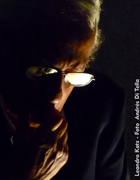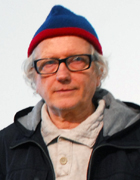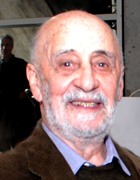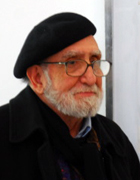11.08.10 - Im�n: Nueva York
August 14. Artist: Eduardo Costa
From August 7, every Saturday at 5 PM
For more information: info@proa.org
A new edition of the Artists + Critics program begins this August. These series have been developed by Proa through the past year and has been received with great public response. Each exhibition brings new critics and artists to a guided visits program developed by the Education Department.
This edition will be a unique historical event that will give visitors the opportunity to dialogue and experience the Imán: New York exhibition with its protagonists.
August
- Saturday 7
5 PM: Leandro Katz – Ana Longoni
6.15 PM: Screening and conversation with the artist at the Auditorium
“Splits”, 1978. 16 mm / DVD, color, sound
“The visit”, 1986. 16 mm / DVD, black and white, sound
- Saturday 14
5 PM: Eduardo Costa – María José Herrera
6.15 PM: Conversation with the artist. Presentation of the sound piece “You see a dress”, 1970
- Saturday 21
5 PM: Alejandro Puente – María Teresa Constantín
- Saturday 28
5 PM: Luis Felipe Noé – Mercedes Casanegra
Coordinated by Mercedes Pérez Bergliaffa
Saturday 7/8 Leandro Katz – Ana Longoni
 Leandro Katz is an artist, writer and director. Known for his films and photographic installations, his works include long term projects that address Latin American issues and incorporate historical research, anthropology and visual arts. He has published twenty three books employing different writing methods such as prose, poetry and artistic (including the cult novels It’s a Wave, Che/Parrot, Soli-dari-dad, Che Guevara in Bolivia, A Chronology, S(h)elf Portrait, and among his most recent publications Natural History, and The Ghost Ñancahuazú (2010). He has produced fourteen documental and un-narrative films, and three narrative ones (among them, La Escisión, The Visit and The Mirror over the Moon). The film Paradox has been selected for “Encuentros del Otro Cine”, Ecuador, 2002 Austria Biennale, Argos 2003, Belgium, and for the 2003 exhibition “Techstos y Photos” at the Museum of Modern Art in Buenos Aires. The Day you Will Love Me received the Coral award at the Latin-American Film Festival of La Havana, the award for best documentary film at the International Film Festival of Valdivia, Chile and an Honors Mention at the International Short Film Festival, Iran, among others. His recent exhibitions include Encuentros de Pamplona 72: fin de fiesta del arte experimental, at the Museum of Reina Sofia , Madrid; Historia Natural, Enrique Faría Fine Art, New York , and was invited to the 10000 Vidas, Gwangju Biennale, Corea, 2010. For his work, he has received fellowships from the Guggenheim Foundation, The National Endowdnment for the Arts, USA, The Arts Council in New York, Jerome Foundation, The Rockefeller Foundation, The Hubert Bals Fund, Holland, among other prestigious institutions. He has guest professor at the School of Visual Arts, New York, and has been a member of the Semiotics Program at Brown University, Rhode Island. He is s professor of Film Theory and Production and the William Paterson University, New Jersey. He lives in Buenos Aires since 2005.
Leandro Katz is an artist, writer and director. Known for his films and photographic installations, his works include long term projects that address Latin American issues and incorporate historical research, anthropology and visual arts. He has published twenty three books employing different writing methods such as prose, poetry and artistic (including the cult novels It’s a Wave, Che/Parrot, Soli-dari-dad, Che Guevara in Bolivia, A Chronology, S(h)elf Portrait, and among his most recent publications Natural History, and The Ghost Ñancahuazú (2010). He has produced fourteen documental and un-narrative films, and three narrative ones (among them, La Escisión, The Visit and The Mirror over the Moon). The film Paradox has been selected for “Encuentros del Otro Cine”, Ecuador, 2002 Austria Biennale, Argos 2003, Belgium, and for the 2003 exhibition “Techstos y Photos” at the Museum of Modern Art in Buenos Aires. The Day you Will Love Me received the Coral award at the Latin-American Film Festival of La Havana, the award for best documentary film at the International Film Festival of Valdivia, Chile and an Honors Mention at the International Short Film Festival, Iran, among others. His recent exhibitions include Encuentros de Pamplona 72: fin de fiesta del arte experimental, at the Museum of Reina Sofia , Madrid; Historia Natural, Enrique Faría Fine Art, New York , and was invited to the 10000 Vidas, Gwangju Biennale, Corea, 2010. For his work, he has received fellowships from the Guggenheim Foundation, The National Endowdnment for the Arts, USA, The Arts Council in New York, Jerome Foundation, The Rockefeller Foundation, The Hubert Bals Fund, Holland, among other prestigious institutions. He has guest professor at the School of Visual Arts, New York, and has been a member of the Semiotics Program at Brown University, Rhode Island. He is s professor of Film Theory and Production and the William Paterson University, New Jersey. He lives in Buenos Aires since 2005.
Ana Longoni is a writer, researcher for CONICET and a professor of Theory of Media and Culture in the Faculty of Arts at the University of Buenos Aires (UBA). Doctor of Arts (UBA), dictates graduate seminars at UBA and PEI-MACBA (Barcelona) on the intersections between art and politics in Argentina and Latin America. She directs the research group Culture as resistance: Readings from the transition from cultural and artistic productions during the last dictatorship in Argentina. She is part of the Southern Conceptual Network since its founding in 2007. She has published individual and collaborative books, such as From the Damned Poets to the Video clips (Buenos Aires, Pitcher, 1998), Del Di Tella a Tucumán Arde (Buenos Aires), Heaven for assault (2000, 2nd edition Eudeba, 2008), the preliminary study of Oscar Masotta book, Revolution in Art (Buenos Aires, Edhasa, 2004), she collaborated in one of the chapters in the anthology edited by I. Katzenstein, Listen, Here, Now! Argentine Art of the Sixties: Writings of the Avant-Garde (New York, MoMA, 2004), Betrayal. The figure of the traitor in the stories on the survivors of the repression (Buenos Aires, Norma, 2007), and the collective volumes The Siluetazo (Buenos Aires, Adriana Hidalgo Editora, 2008) and Southern Conceptualisms (São Paulo, Annablume , 2009). Her play La Chira was released in 2004, directed by Ana Alvarado, and was included in the anthology edited by Jorge Dubatti, New Argentinean theater: drama(s), La Havana, La Honda, 2007. Trees, another play, was released in Buenos Aires under her direction in 2006. She is a member of the editorial board for the Ramona, Ojos Cureles and Des-edges journals.
Saturday 14/8 Eduardo Costa – María José Herrera
 Eduardo Costa was born in Buenos Aires in 1940. He studied Literature and Art History at the University of Buenos Aires (UBA). Early in his career, he founded and collaborated with the magazine Airón, a publication that disclosed theoretical writings, and national and international poetry and literature. Under the theoretical writings and activity of Oscar Massota, he became interested in the connection between artistic practice, performance, cultural industry products and mass media as a new field for experimentation. In 1966, he wrote with Raul Escari and Roberto Jacoby Media and Communication Art, a manifesto on the “new artistic materials” and its relation to mass media production and uses. At the same time, the three artists carried out the Happening for a late wild boar or Happening of complete participation. Also in 1966, under the influence of the The Fashion System by Roland Barthes, he developed with Juan Risuela A Fashion (Tale). In 1967, Costa travelled to New York and presented Fashion Fiction to Vogue Magazine, who published it at the beginning of 1968. In 1969, Costa wrote the manifesto Useful Art, for Street Works, a piece made in New York by a group of poets and artists. Along with Hannah Weiner and John Perrault he developed that same year, The Fasion Poetry Event, in which artists such as Claes Oldenburgh, Andy Warhol, James Rosenquist, Marisol, Alex Katz, Marjorie Strider, participates. Moreover he edited with Perrault, Tape Poems. Its first edition was composed of 500 copies, made with a stereophonic tape made specially by Burton, Vito Acconci, Dan Graham, and the editors, among others. In 1971, Costa returned to Argentina. En 1977, he presented Homage to Marcel Duchamp. A year later he moved to Rio de Janeiro and become part of the group lead by Helio Oiticica. In 1981, he returned to New York. Throughout the decade, he wrote the lyrics for the rock band Virus. In the early 90s he started to write for Flash Art, Art in America and began working on his volumetric paintings.
Eduardo Costa was born in Buenos Aires in 1940. He studied Literature and Art History at the University of Buenos Aires (UBA). Early in his career, he founded and collaborated with the magazine Airón, a publication that disclosed theoretical writings, and national and international poetry and literature. Under the theoretical writings and activity of Oscar Massota, he became interested in the connection between artistic practice, performance, cultural industry products and mass media as a new field for experimentation. In 1966, he wrote with Raul Escari and Roberto Jacoby Media and Communication Art, a manifesto on the “new artistic materials” and its relation to mass media production and uses. At the same time, the three artists carried out the Happening for a late wild boar or Happening of complete participation. Also in 1966, under the influence of the The Fashion System by Roland Barthes, he developed with Juan Risuela A Fashion (Tale). In 1967, Costa travelled to New York and presented Fashion Fiction to Vogue Magazine, who published it at the beginning of 1968. In 1969, Costa wrote the manifesto Useful Art, for Street Works, a piece made in New York by a group of poets and artists. Along with Hannah Weiner and John Perrault he developed that same year, The Fasion Poetry Event, in which artists such as Claes Oldenburgh, Andy Warhol, James Rosenquist, Marisol, Alex Katz, Marjorie Strider, participates. Moreover he edited with Perrault, Tape Poems. Its first edition was composed of 500 copies, made with a stereophonic tape made specially by Burton, Vito Acconci, Dan Graham, and the editors, among others. In 1971, Costa returned to Argentina. En 1977, he presented Homage to Marcel Duchamp. A year later he moved to Rio de Janeiro and become part of the group lead by Helio Oiticica. In 1981, he returned to New York. Throughout the decade, he wrote the lyrics for the rock band Virus. In the early 90s he started to write for Flash Art, Art in America and began working on his volumetric paintings.
María José Herrera has a degree in Arts from the University of Buenos Aires (UBA). She is Chief Curator and Researcher for the Museum of Fine Arts in Buenos Aires (MNBA) and president of the Argentina Art Critics Association (AICA-AACA). In 2008 she became Artistic Director for MNBA. She received several scholarships from different cultural and academic institutions in the country and abroad (National Endowment for the Arts, Antorchas Foundation, Rockefeller Foundation, Lampadia Foundation) and focused her research in Argentine art and museum studies from a historical perspective, from cultural policy, and curatorial Studies and technique. In 2002, she developed a study group that analyzed the role of exhibitions and its effect on Art history writings, and later conducted workshops and publications that showed the results. She is curator of the permanent collection galleries at MNBA. She curated exhibitions in Brazil and Chile. She is editor and author of numerous MNBA publications. Her essays have been publishes in scholarly mediums in Argentina and abroad. Her most recent publication is Argentinean Art Exhibitions (Buenos Aires, AAMNBA, 2009).
Saturday 21/8 Alejandro Puente – María Teresa Constantín
 Alejandro Puente was born in La Plata in 1933. He studied Visual Theory with Hector Cartier at the Faculty of Arts of La Plata City. During the 60s he participated in several exhibitions hosted by prominent galleries in Buenos Aires, including Rioboo, Bonino, Ruth Benzacar and Lirolay, where in 1964 presented along with César Paternosto Sensible Geometry. He also showed in galleries abroad. He participated in the Yes Group, and in 1961 produced his first group exhibition at the Museo de Bellas Artes de La Plata and the Museum of Modern Art in Buenos Aires (MAMBA). Participated in the first Braque Awards, in 1964 and the Ver y Estimar. In 1966 he was invited to the Di Tella Nacional Award exhibition and the famous exhibition The Visual Artists Homage to the Viet-Nam organized by León Ferrari and Carlos Gorriarena at the Van Riel Gallery. In 1967 his work was included at the Beyond Geometry (Más allá de la geometría) exhibition, held at the Di Tella Institute in Buenos Aires. In 1967 he obtained a Guggenheim Fellowship, and traveled to New York where he lived for the next four years. In 1968 his work was included in the American version of Beyond Geometry, held at the Center for Inter-American Relations in New York and in the Latin American Artists exhibition at the Delaware Art Center, USA. He participated in Information Show, 1970, at the Museum of Modern Art in New York. Thereafter, he was part of group exhibitions in Switzerland, Germany, France, Spain, Italy, Mexico, Cuba, Japan and China. He also made numerous solo exhibitions in Argentina and was the Argentine representative at the Biennale de São Paulo in 1985. In 1992 and 2004, he obtained the Konex Foundation Award . He has been appointed a Lifetime Academic Award at the National Academy of Fine Arts. He lives and works in Buenos Aires.
Alejandro Puente was born in La Plata in 1933. He studied Visual Theory with Hector Cartier at the Faculty of Arts of La Plata City. During the 60s he participated in several exhibitions hosted by prominent galleries in Buenos Aires, including Rioboo, Bonino, Ruth Benzacar and Lirolay, where in 1964 presented along with César Paternosto Sensible Geometry. He also showed in galleries abroad. He participated in the Yes Group, and in 1961 produced his first group exhibition at the Museo de Bellas Artes de La Plata and the Museum of Modern Art in Buenos Aires (MAMBA). Participated in the first Braque Awards, in 1964 and the Ver y Estimar. In 1966 he was invited to the Di Tella Nacional Award exhibition and the famous exhibition The Visual Artists Homage to the Viet-Nam organized by León Ferrari and Carlos Gorriarena at the Van Riel Gallery. In 1967 his work was included at the Beyond Geometry (Más allá de la geometría) exhibition, held at the Di Tella Institute in Buenos Aires. In 1967 he obtained a Guggenheim Fellowship, and traveled to New York where he lived for the next four years. In 1968 his work was included in the American version of Beyond Geometry, held at the Center for Inter-American Relations in New York and in the Latin American Artists exhibition at the Delaware Art Center, USA. He participated in Information Show, 1970, at the Museum of Modern Art in New York. Thereafter, he was part of group exhibitions in Switzerland, Germany, France, Spain, Italy, Mexico, Cuba, Japan and China. He also made numerous solo exhibitions in Argentina and was the Argentine representative at the Biennale de São Paulo in 1985. In 1992 and 2004, he obtained the Konex Foundation Award . He has been appointed a Lifetime Academic Award at the National Academy of Fine Arts. He lives and works in Buenos Aires.
María Teresa is a historian and art critic, graduate from the Museum School at the Louvre. She has worked in museums in France, Spain and Argentina. She has published books, essays and scholarly articles. She curated various exhibitions and was a member of the jury in numerous awards for visual arts. She is a member of the Centro Argentino de Investigadores de Arte and the Argentina Art Critics Association. She is the coordinator of Art at OSDE Foundation in Buenos Aires.
Saturday 28/8 Luis Felipe Noé – Mercedes Casanegra
 Luis Felipe Noé is an artist, writer, intellectual and teacher. In 1961 formed the Group New Figurative Art from Argentina, with Ernesto Deira, Rómulo Macció y Jorge de la Vega. The group made several exhibitions in the Nacional Museum of Fine Arts in Buenos Aires (MNBA), the Museum of Modern Art in Rio de Janerio and The Recoleta Cultural Center, among others. He has been part of more than forty solo exhibitions in museums and galleries throughout Latin America, Europe and the United States. His most important exhibitions were produced at the National Museum of Fine Arts in Caracas, The National Palace Museum in Mexico, The Borges Cultural Center and the MNBA. His been invited to participate in Biennales in La Havana, Sao Paulo, Mercosur and Venice. Received the Di Tella National Award, the Guggenheim Fellowship, the Lifetime artist award from the Argentina Art Critics Association, The Grand Price from the National Art Fund and the Lifetime award from the city of Rosario.
Luis Felipe Noé is an artist, writer, intellectual and teacher. In 1961 formed the Group New Figurative Art from Argentina, with Ernesto Deira, Rómulo Macció y Jorge de la Vega. The group made several exhibitions in the Nacional Museum of Fine Arts in Buenos Aires (MNBA), the Museum of Modern Art in Rio de Janerio and The Recoleta Cultural Center, among others. He has been part of more than forty solo exhibitions in museums and galleries throughout Latin America, Europe and the United States. His most important exhibitions were produced at the National Museum of Fine Arts in Caracas, The National Palace Museum in Mexico, The Borges Cultural Center and the MNBA. His been invited to participate in Biennales in La Havana, Sao Paulo, Mercosur and Venice. Received the Di Tella National Award, the Guggenheim Fellowship, the Lifetime artist award from the Argentina Art Critics Association, The Grand Price from the National Art Fund and the Lifetime award from the city of Rosario.
Mercedes Casanegra is an Art Historian (UBA), writer, and contemporary art researcher. She is an Art Aesthetics professor at the Literature and Philosophy School at the University of Buenos Aires. She was president of the Argentinean Art Critics Association (AACA-AICA) from 2001 until 2006. Robert Elía, Enio Iomi, Kazuya Sakai, Eduardo Stupía, Matilde Marin are some of the artists present in her most recent exhibitions. Other shows include Between Silence and Violence, at Telefónica Foundation in Buenos Aires and Sotheby’s, New York. She was in charge of the Argentinean correspondent for the 2003 Biennale and for De la Vega at MALBA. She was a guest art consultant for the Latin-American artwork selection for the exhibition In the Time of Art, curated by Giacinto Di Pietrantonio, Fundación PROA.
